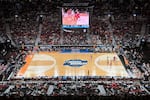
Texas and North Carolina State play during the second half of an Elite Eight college basketball game in the women's NCAA Tournament, Sunday, March 31, 2024, in Portland, Ore. Women’s basketball fans could watch teams compete in the NCAA Sweet 16 and Elite 8 rounds at the Sports Bra the now-famous Northeast Portland sports bar that only plays women’s sports.
Tim Booth / AP
For decades March Madness was a familiar scene for women’s basketball fans: Walk into a sports bar, see all the TVs turned to the men’s tournament, and ask the bartender to change at least one screen to the women’s game.
But women’s sports experts say that scene is slowly fading thanks to years of focused investments and increasing media coverage. Many point to Portland as an example.
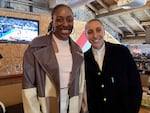
WNBA greats Nneka Ogwumike of the Seattle Storm and Diana Taurasi of the Phoenix Mercury at the Sweet 16 watch party at Spirit of 77 on Friday, March 29, 2024, in Portland, Ore. The Sports Bra, media company TOGETHXR and Aflac Insurance sponsored the party.
Kyra Buckley / OPB
Over Easter weekend, women’s basketball fans could watch teams compete in the NCAA Sweet 16 and Elite 8 rounds at the Sports Bra, the now-famous Northeast Portland sports bar that only plays women’s sports. If the Sports Bra was full, fans headed to an area bar that agreed ahead of time to put the women’s tournament on TV. Or, they were able to go to the Moda Center, where six tournament games were played.
And on Friday and Saturday, there was a celebrity-stacked Sweet 16 watch party at the sports bar Spirit of 77. The party was a collaboration between Sports Bra, media company TOGETHXR and Aflac Insurance. The public event drew WNBA stars to Portland like Nneka Ogwumike, Elena Delle Donne and Diana Taurasi.

Spirit of 77 hosted a Sweet 16 watch party for the NCAA women's tournament on Mar. 29 and 30 in Portland, Ore. The Sports Bra, media company TOGETHXR and Aflac Insurance sponsored the party.
Kyra Buckley / OPB
“Right now women’s sports in general is on the radar,” Taurasi, an Olympic gold medalist and Phoenix Mercury player, told OPB. “It’s on the radar for a lot of companies and sponsorships and it’s on TV – and I think that’s what you need. The game’s always been great, there’s nothing new under the sun.”
Two decades ago, Taurasi led the University of Connecticut to three NCAA titles. The difference now, Taurasi said, is that players like her are household names, something past generations of women hoopers experienced to a far lesser degree, if at all.
College athletes in Portland for the Sweet 16 and Elite 8 at the Moda Center echoed that sentiment to reporters. Eight teams traveled to the Rose City: Texas, Gonzaga, Stanford, University of Southern California, North Carolina State, Baylor, Duke and Connecticut. From the Portland Region, North Carolina State and Connecticut will head to the final four.
Connecticut’s standout point guard for this year’s team saw the same evolution as Taurasi, who played the same position for the Huskies years before.
“Women’s sports have always been great, it’s just now we’re getting the attention we deserve,” Paige Bueckers said at a press conference ahead of her team’s Sweet 16 win over Duke on Saturday. “You see us more in the media, you see us more on Instagram, Twitter, whatever exists.”
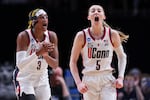
UConn guard Paige Bueckers (5) and UConn forward Aaliyah Edwards (3) react during the first half of the team's Sweet 16 college basketball game against Duke in the women's NCAA Tournament, Saturday, March 30, 2024, in Portland, Ore.
Howard Lao / AP
Bueckers said the increasing media attention is, in turn, translating into record viewership.
That’s intentional, according to Jessica Robertson, co-founder and chief content officer for TOGETHXR.
Robertson said for years sports marketing was stuck in a vicious cycle: Brands questioned the return on investment for the women’s game and shied away from spending. In turn, that meant little coverage of women’s teams and athletes. Seeing little coverage, brands assume it’s a risky bet, and the cycle continues.
“We were launched and founded with the mission to disrupt that cycle,” Robertson said, “And to start, first and foremost, with storytelling to make these incredible athletes centered and visible, maybe in a way they never have been before.”
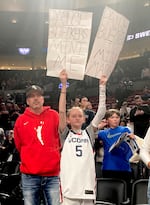
A fan of Connecticut basketball star Paige Bueckers sports "Paige Bueckers' Mini Me" and "Paige Bueckers is Miss March" signs at the Moda Center on Saturday, Mar. 30, 2024. The Connecticut Huskies beat Duke to advance to the Elite 8 in Portland.
Kyra Buckley / OPB
That approach seems to be working. Previously, UNESCO research estimated women’s sports only received 4% of total sports coverage. In recent years that number is closer to around 15%, according to research from the Wasserman Collective.
Also in recent years, women’s sports have been setting – and then breaking – viewership and attendance records. It’s likely that people who don’t follow the sport have heard of players like Caitlin Clark of Iowa, Angel Reese of Louisiana State or JuJu Watkins of USC.
“I think we’re going into a Final Four weekend where viewership records, again, are going to be broken for ESPN, which is incredibly exciting for us, even just as fans, not just as a media company who’s trying to drive that change,” Robertson said. “So the idea that no one watches women’s sports is tired and old – because everyone watches women’s sports.”
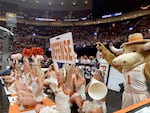
The spirit squad from the University of Texas at the Moda Center on Sunday, March 31, 2024. The Texas Longhorns fell to North Carolina State in the Elite 8 of the women's NCAA tournament.
Kyra Buckley / OPB
She says that last part with a smile because TOGETHXR literally created the shirt that says “Everyone watches women’s sports.” It’s meant to be a tongue-in-cheek response to internet trolls who proclaim the opposite in comment sections.
Meanwhile, TOGETHXR has struggled to keep the shirt in stock. It’s been seen on star athletes and coaches across the country, including on South Carolina head coach Dawn Staley during a nationally televised game.
One reason more people are watching the NCAAW tournament, Robertson said, is because there are simply more places to gather with other fans and enjoy the games. Portland has the Sports Bra, and similar concepts exist in Seattle and Minneapolis. And for this year’s tournament, TOGETHXR distributed a list of sports bars across the country that pledged to show women’s March Madness.
In-person attendance during NCAAW first and second rounds games played on campuses across the country already broke records set just last year, leaping from a total of 232,000 in 2023 to 292,000 this year.

Baylor University fans at the Moda Center in Portland, Ore. on Saturday, March 30, 2024. Baylor fell to USC in the Sweet 16 of the women's NCAA tournament.
Kyra Buckley / OPB
The NCAA had two regional sites for the Sweet 16 and Elite 8. In the Albany, New York region, more than 13,000 fans attended games. Here in Portland, despite no local team playing in the region, more than 12,000 people spent part of the weekend at the Moda Center.
Hundreds more attended the watch party at Spirit of 77, including Lavanya Nolan along with her two friends. All three are fans of college and professional women’s hoops. Nolan said she played basketball growing up and now coaches girls’ sports in Portland.
“I’m just excited for the growing fan base,” Nolan said. “People who maybe weren’t interested in the sport before are attaching to teams and players and the coaches, and are trying to follow them along their journey from the college level to if they go pro or if they switch teams.”
All-star WNBA player Nneka Ogwumike, who will play for the Seattle Storm in the upcoming season starting in May, said another thing driving coverage is increasing parity between teams. For decades, if college teams grabbed headlines, it was programs like Connecticut or Ogwumike’s former school, Stanford.
While those legendary and highly decorated programs remain in the news, schools like Iowa, USC, and Oregon State are among those getting a good share of media attention this March Madness. Ogwumike said it shows that respect for the women’s game is growing – both internally at schools and externally among fans and media organizations – when teams with different styles are getting national attention.
“I’m just excited to see the evolution of so many different teams in that way,” Ogwumike told OPB while she was in Portland Friday. “And I just love seeing women being superstars.”
Robertson at TOGETHXR says for longtime fans of women’s hoops, this year’s tournament feels refreshing. Games are readily available on major networks. Fans have multiple choices of where to watch the games, especially in cities like Portland. Companies such as Aflac are partnering with pioneers like TOGETHXR to drive marketing dollars toward the women’s game. Individual players are becoming household names.
Yet, there’s still more to be done, Robertson said.
“I can’t wait for a time when we don’t have to talk about why you should invest in women’s sports – it’s just a thing that you’re doing,” she said. “We’re getting there. But this feels like a turning point, this time in sports history.”
